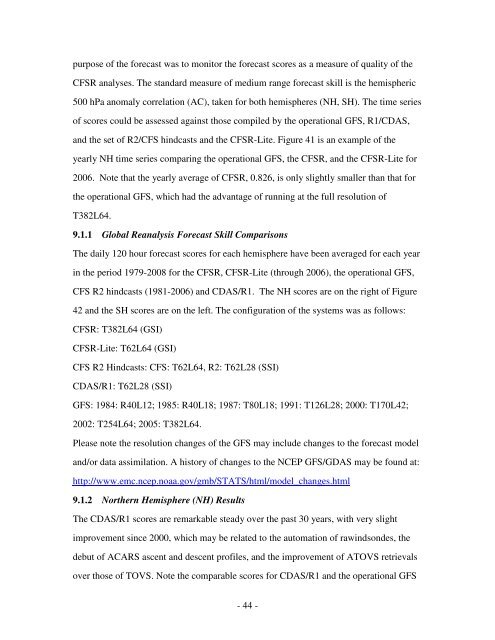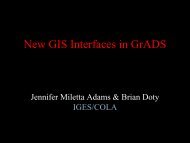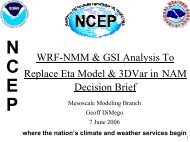The NCEP Climate Forecast System Reanalysis - NOAA National ...
The NCEP Climate Forecast System Reanalysis - NOAA National ...
The NCEP Climate Forecast System Reanalysis - NOAA National ...
Create successful ePaper yourself
Turn your PDF publications into a flip-book with our unique Google optimized e-Paper software.
purpose of the forecast was to monitor the forecast scores as a measure of quality of theCFSR analyses. <strong>The</strong> standard measure of medium range forecast skill is the hemispheric500 hPa anomaly correlation (AC), taken for both hemispheres (NH, SH). <strong>The</strong> time seriesof scores could be assessed against those compiled by the operational GFS, R1/CDAS,and the set of R2/CFS hindcasts and the CFSR-Lite. Figure 41 is an example of theyearly NH time series comparing the operational GFS, the CFSR, and the CFSR-Lite for2006. Note that the yearly average of CFSR, 0.826, is only slightly smaller than that forthe operational GFS, which had the advantage of running at the full resolution ofT382L64.9.1.1 Global <strong>Reanalysis</strong> <strong>Forecast</strong> Skill Comparisons<strong>The</strong> daily 120 hour forecast scores for each hemisphere have been averaged for each yearin the period 1979-2008 for the CFSR, CFSR-Lite (through 2006), the operational GFS,CFS R2 hindcasts (1981-2006) and CDAS/R1. <strong>The</strong> NH scores are on the right of Figure42 and the SH scores are on the left. <strong>The</strong> configuration of the systems was as follows:CFSR: T382L64 (GSI)CFSR-Lite: T62L64 (GSI)CFS R2 Hindcasts: CFS: T62L64, R2: T62L28 (SSI)CDAS/R1: T62L28 (SSI)GFS: 1984: R40L12; 1985: R40L18; 1987: T80L18; 1991: T126L28; 2000: T170L42;2002: T254L64; 2005: T382L64.Please note the resolution changes of the GFS may include changes to the forecast modeland/or data assimilation. A history of changes to the <strong>NCEP</strong> GFS/GDAS may be found at:http://www.emc.ncep.noaa.gov/gmb/STATS/html/model_changes.html9.1.2 Northern Hemisphere (NH) Results<strong>The</strong> CDAS/R1 scores are remarkable steady over the past 30 years, with very slightimprovement since 2000, which may be related to the automation of rawindsondes, thedebut of ACARS ascent and descent profiles, and the improvement of ATOVS retrievalsover those of TOVS. Note the comparable scores for CDAS/R1 and the operational GFS- 44 -





